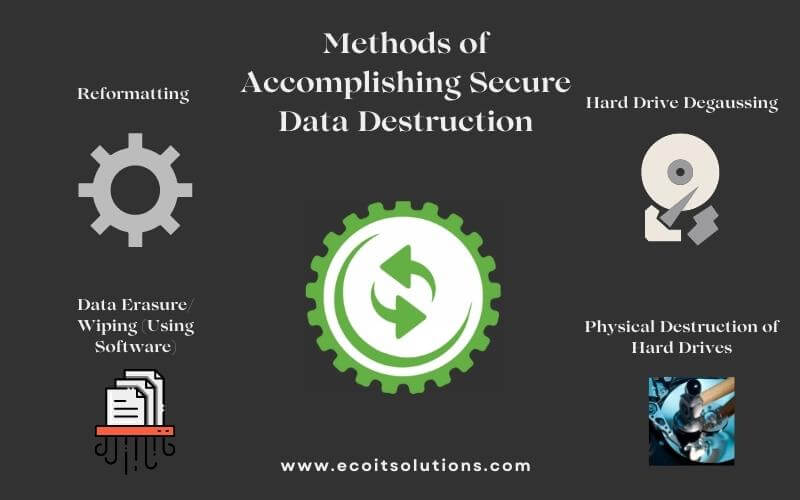The Significance of Effective Information Damage Practices in Shielding Sensitive Details and Ensuring Computer System Safety And Security
In an age where information violations are progressively common, the importance of efficient information damage practices can not be overemphasized. Organizations face substantial risks when sensitive details is inadequately gotten rid of, possibly bring about unapproved accessibility and extreme monetary effects. Implementing durable data devastation approaches not just minimizes these risks but additionally straightens with lawful conformity needs, guaranteeing that companies promote their track record and foster customer trust fund. The inquiry continues to be: what particular strategies can be used to improve these practices, and just how can organizations efficiently integrate them right into their general cybersecurity structure?
Understanding Information Destruction
Understanding information damage is essential in today's electronic landscape, where delicate information can conveniently be jeopardized. Efficient information damage includes not merely deleting documents yet guaranteeing that data is irretrievable through extensive techniques. This procedure is vital for companies that manage personal client info, copyright, or inner records, as any type of breach can lead to severe monetary and reputational consequences.
Data destruction encompasses various methods, including shredding physical media, degaussing magnetic storage gadgets, and employing software-based remedies that overwrite data numerous times. Each approach offers a specific objective and needs to align with the level of sensitivity of the information being dealt with. For instance, physical destruction is frequently preferred for difficult drives having highly personal information, while software program techniques might be adequate for less sensitive information.
In addition, adhering to market standards and regulations, such as the General Data Protection Regulation (GDPR) or the Medical Insurance Portability and Responsibility Act (HIPAA), is crucial for compliance and to mitigate lawful dangers. Organizations should create a robust information devastation plan, train staff members on ideal methods, and frequently investigate their treatments to make sure that all sensitive info is dealt with safely and efficiently.
Risks of Inadequate Practices
Insufficient information devastation practices subject companies to significant risks that can have significant repercussions. When delicate info is not effectively disposed of, it remains susceptible to unauthorized access, which can cause data violations and identification theft. Such cases not just endanger the safety of individuals but additionally stain the company's reputation, resulting in a loss of consumer depend on and potential monetary consequences.
Furthermore, governing compliance is significantly rigorous in numerous markets. Failing to comply with data devastation laws can result in substantial penalties and lawsuits against organizations. These penalties can divert and strain economic sources attention from core business operations.
In enhancement, the abuse of residual information can lead to copyright theft or company espionage, jeopardizing affordable advantages (data destruction). The effect of poor information damage expands beyond immediate economic losses; it can also cause long-lasting damage to brand stability and market placement

Organizations should recognize that information protection is not only concerning preventing violations; it additionally includes the responsible management of data throughout its lifecycle. Neglecting effective information destruction methods can have catastrophic ramifications, emphasizing the need for robust procedures to alleviate these threats.
Finest Practices for Information Destruction
Carrying out reliable information destruction practices is vital for safeguarding delicate info and keeping compliance with regulative standards. Organizations must adopt a multi-faceted approach to make certain that information is irretrievable, thus avoiding unauthorized gain access to and potential breaches.
First, information need to be categorized based upon level of sensitivity, allowing companies to use suitable destruction approaches customized to the level of risk. For electronic data, making use of software-based data-wiping tools that abide with market criteria can efficiently my response overwrite existing information. Physical damage methods, pop over to this web-site such as shredding or degaussing, are essential for devices that store sensitive information, making sure complete obliteration.
Establishing a clear information retention plan is vital, outlining the length of time different types of info should be maintained prior to damage. Regular audits of information storage systems are also needed to identify outdated or unnecessary data needing elimination.
In addition, training staff members on the value of data damage and the certain procedures to adhere to fosters a society of security within the company. Ultimately, preserving documentation of data devastation refines provides liability and supports compliance with inner policies and exterior regulations. By sticking to these ideal techniques, organizations can dramatically alleviate the risks related to information direct exposure.
Legal and Conformity Factors To Consider

Failing to adhere to these guidelines can cause serious fines, including significant penalties and reputational damage. Organizations needs to implement a durable information damage policy that aligns with these lawful structures and supplies clear guidelines on the correct methods of information disposal, whether physical shredding or electronic cleaning.
In addition, maintaining paperwork of data damage activities is essential for showing compliance during audits or inspections. By focusing on lawful and conformity considerations, companies can enhance their information protection posture and foster trust with stakeholders and clients, eventually adding to a much more secure data monitoring atmosphere.
Benefits of Effective Information Devastation
Reliable information destruction methods expand past plain compliance; they use substantial advantages to companies that prioritize them. By making sure that sensitive information is irretrievably damaged, companies minimize the risk of data violations and the potential financial repercussions connected with them. This aggressive strategy not just safeguards against unapproved access yet likewise improves look at here the general reliability of the company in the eyes of stakeholders and clients.
Applying durable information destruction techniques, such as physical devastation of storage space tools or sophisticated information wiping strategies, adds to the strengthening of an organization's cybersecurity pose. data destruction. It decreases the likelihood of intellectual property theft and protects exclusive information, thereby keeping an one-upmanship in the marketplace

Final Thought
Finally, reliable information damage methods are important for securing sensitive information and improving total computer system safety. By implementing thorough methods such as software, shredding, and degaussing overwriting, organizations can alleviate the threats connected with unapproved gain access to and information breaches. Adherence to governing criteria, including GDPR and HIPAA, further reinforces conformity and protects against lawful consequences. Ultimately, a commitment to durable information devastation methods fosters a culture of duty, consequently enhancing an organization's cybersecurity posture and maintaining client trust fund.
/prod01/channel_3/media/tcd/itservices/images/Untitled-design-(26).png)